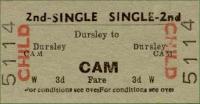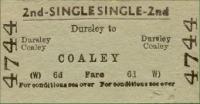

 |
 |
||||||||
| The Dursley Railway | |||||||
| The origins of the Dursley Railway revolve around the existence of the cloth-making industry in the Cam valley back in the early 19th Century. In those days, unlike today, this was the dominant industry and the mills in the area had a reputation for quality. |  |
||||||
|
The 1840's was the beginning of a period of rapid expansion and industrial growth on a large scale. Dursley, however was at a disadvantage compared with similar mills in the Stroud valleys which had direct transport links with the Stroudwater and Thames & Severn canals and the Great Western Railway. In 1844 the broad gauge Bristol and Gloucester Railway was built to connect the two cities but this bypassed Dursley, passing over two miles west of the town. The B&G Railway was soon taken over by the Midland Railway and the mill owners petitioned it to provide a station at Cam Bridge but this was refused. It then fell to local action to push ahead with the struggle to open a station for the town. A public meeting was held in 1852 where it was decided to try to open a branch line from the now standard gauge main line at a point near Coaley and in 1855 the Dursley & Midland Junction Railway was formed. The route decided upon would follow the Cam valley and terminate in Dursley close to the bottom of Long Street. Fundraising began towards the projected cost of around £14100 and in late 1855 a contract was agreed and construction of the line began. Progress was rapid, the priority was to get return on investment from goods traffic and the line opened for goods on August 25th 1856. However passenger activity was not far behind, stations were built at Coaley Junction, Cam and Dursley and they were brought into use when the line opened fully on September 18th 1856. The stations were in a distinctive style, being designed and built by the independent D&MJR Company. However this independence only lasted for five more years during which time it was realised that the income from goods traffic was not up to the levels expected. It was inevitable that in 1861 the Midland Railway took over all the interests and the running of the smaller company and a new phase in its life began. Following the Midland's takeover the line became relatively prosperous, particularly once Lister's started to make use of it for conveying its production output. There were also many private sidings along its route serving the various mills and factories in the valley. Passenger usage however was never heavy, owing perhaps to its position some distance from the town centre. This pattern continued up to the 1930's after which increasing competition from buses began to hit profits. Passenger traffic struggled on until final closure occurred on September 10th 1962 although the station at Coaley Junction stayed open for main line traffic until 1965 after which it too succumbed. |
|||||||
 |
Goods traffic did continue though, serving only the Lister's factory after all other sidings had been closed. The final British Railways train left Dursley station on June 28th 1968 after which the branch was shortened and operated effectively as a private siding. |
||||||
|
However on July 11th 1970, following a collision by a bus with the low Quag bridge which severed the link, after a total period of 114 years the Dursley branch line closed for good. This wasn't quite the end of train traffic for Dursley though. In 1994, after a period of 29 years and a concerted effort from the Coaley Junction Action Committee a new station was opened close to the site of the original Coaley Junction station, all buildings of which had long since been demolished.This new station, Cam and Dursley, continues to serve as a commuter stop for the increasing number of people travelling to Bristol, Gloucester and further afield. Of the branch line itself, few relics remain and it is often not obvious what their origin is.
|
|||||||